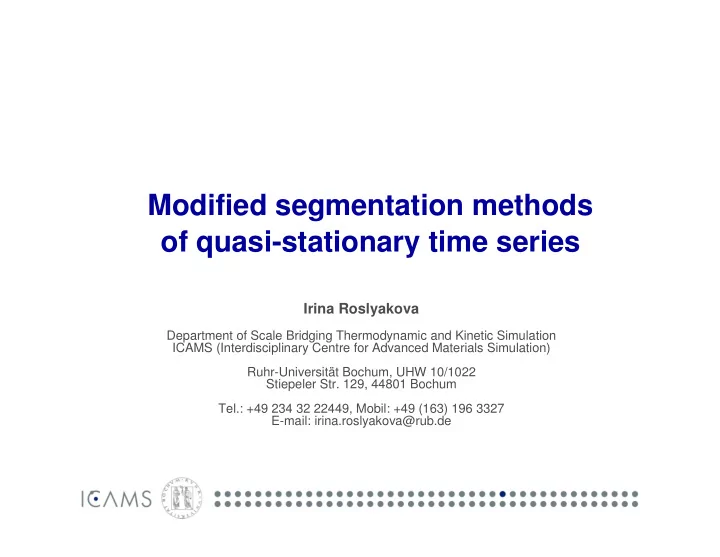

Modified segmentation methods of quasi-stationary time series Irina Roslyakova Department of Scale Bridging Thermodynamic and Kinetic Simulation ICAMS (Interdisciplinary Centre for Advanced Materials Simulation) Ruhr-Universität Bochum, UHW 10/1022 Stiepeler Str. 129, 44801 Bochum Tel.: +49 234 32 22449, Mobil: +49 (163) 196 3327 E-mail: irina.roslyakova@rub.de
Contents � Problem importance � Method of Pedro Bernaola-Galván et al. � Modified segmentation algorithm � Comparison: Modified segmentation algorithm vs. R-Package “ strucchange” � Conclusion This work is part of my master thesis performed in BASF SE, Germany 2
Problem importance � Many time series are a sequence of stationary intervals � The statistical analysis of such quasi-stationary processes requires a division of the measurements into different stationary time segments. � The segmentation of quasi-stationary time series is a tedious computational problem � For large samples statistical methods will be too time consuming. Heuristics have to be applied. � Possible application � Medicine � Chemical production processes � Internet traffic fluctuations 3
Method of Pedro Bernaola-Galván et al. Statistic t for comparison mean value of two samples is calculated for every position of sliding point p from start of interval left right − m m = x x t ( p ) , S is the pooled variance i D S D till the end of intervall Point p with maximal difference in mean value is DOI: 10.1103/PhysRevLett.87.168105 checked by using modified T-Test η { } ( ) ( ) ≈ 1- δν δ , P t I max 2 ν ν + [ /( t )] max = − v N 2 I ( a,b ) is the incomplete beta function where is the number of degrees of freedom, x Significance of cutting point p is checked under condition that minimal length of subintervals have to be not less that some used defined value left ≥ l l ( ) ( ) 0 p c = ≥ P = p t P t 0 . 95 we cut the series at point and max 0 max right ≥ l l 0 4
Method of Pedro Bernaola-Galván et al. Analysis of the vapor consumption in a chemical production Observation Vapor consumption window: Method is sensitive but not robust against 30 days significant outliers near boundaries 30 days Vapor consumption 85 days no segmentation outliers 85 days Time 5
Modified segmentation algorithm � Bernaola-Galván’s method is sensitive but not robust against significant outliers near boundaries Vapor consumption Observation window: 85 days Time � Modification to make algorithm robust against outliers near boundaries The length of right subinterval is less than minimal allowed value l 0 Pedro Bernaola-Galván Modified method 6
Modified segmentation algorithm Analysis of the vapor consumption in a chemical production Vapor consumption Observation window: Segmentation result are independent of observation 30 days window and outliers. 30 days Vapor consumption 85 days outliers Time index 85 days Time 7
Segmentation Steps in Comparison Pedro Bernaola-Galván Modified method 1 1 2 2 3 4 3 4 5 5 6 6 8
Modified Segmentation: Steps Vapor consumption Vapor consumption Observation window: t t t 1 2 1 30 days 30 days 30 days Time Time Vapor consumption Vapor consumption t t t t t t t 2 3 1 2 3 1 4 Time Time 9
Modified segmentation vs. " strucchange" R-Package strucchange Vapor consumption, t/h (+) breaks in time series with trends 0.175 can also be recognized (-) slower (49.08 sec) 0.165 0 100 200 300 400 500 600 700 Time index Modified segmentation Time index Vapor concsumption, t/h 0.175 (+) much faster (0.68 sec) (-) only for breaks in stationary data 0.165 0 100 200 300 400 500 600 700 Time index 10
Conclusion � Heuristic method proposed by Pedro Bernaola-Galván et al. was implemented in R and analyzed � Analysis of original segmentation algorithms showed that this method in not robust to outliers near to bounds � Original algorithms was modified and show good resistant to influence of outliers near bounds � Algorithm is limited to stationary segments. � The modified segmentation method was compared with functions breakpoints from R-package strucchange and its computational efficiency was shown 11
Literature � Bernaola-Galván, Pedro; Ivanov, Plamen Ch.; Amaral, Luís A. Nunes; Stanley, H. Eugene: Scale Invariance in the Nonstationarity of Human Heart Rate. In: Physical review letters (2001), Volume 87, number 16 (abgerufen am 13. August 2009). http://polymer.bu.edu/hes/articles/bias01.pdf � Fukuda, Kensuke; Stanley, H. Eugene; Amaral, Luı´s A. Nunes: Heuristic segmentation of a nonstationary time series. In: Physical review letters 69 (2004). � Zeileis, Achim; Leisch, Friedrich; Hansen, Bruce; Hornik, Kurt; Kleiber, Christian: Package „strucchange“, 2009 (Version 1.3-7 ) � Zeileis, Achim; Leisch, Friedrich; Hornik, Kurt; Kleiber: strucchange: An R Package for Testing for Structural Change in Linear Regression Models (Version 1.3-7 ) http://cran.r- project.org/web/packages/strucchange/vignettes/strucchange-intro.pdf 12
Recommend
More recommend